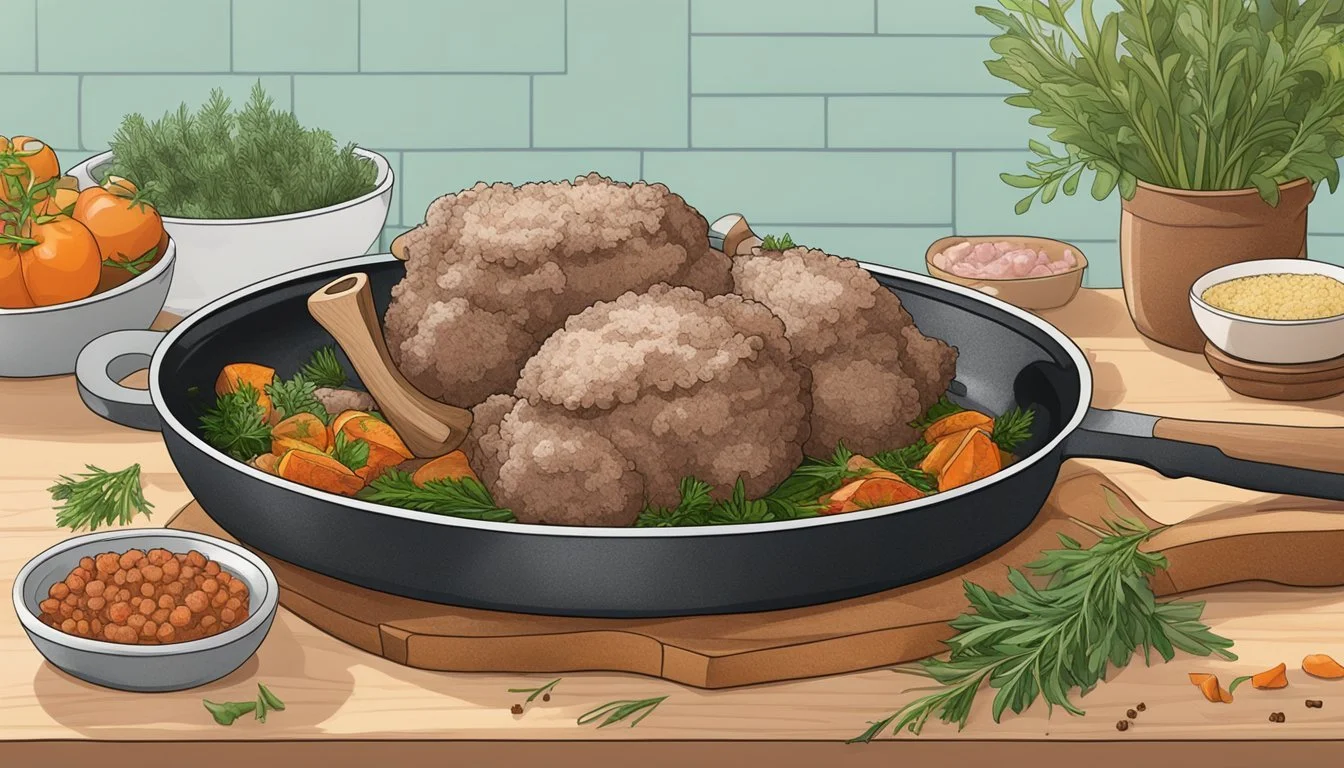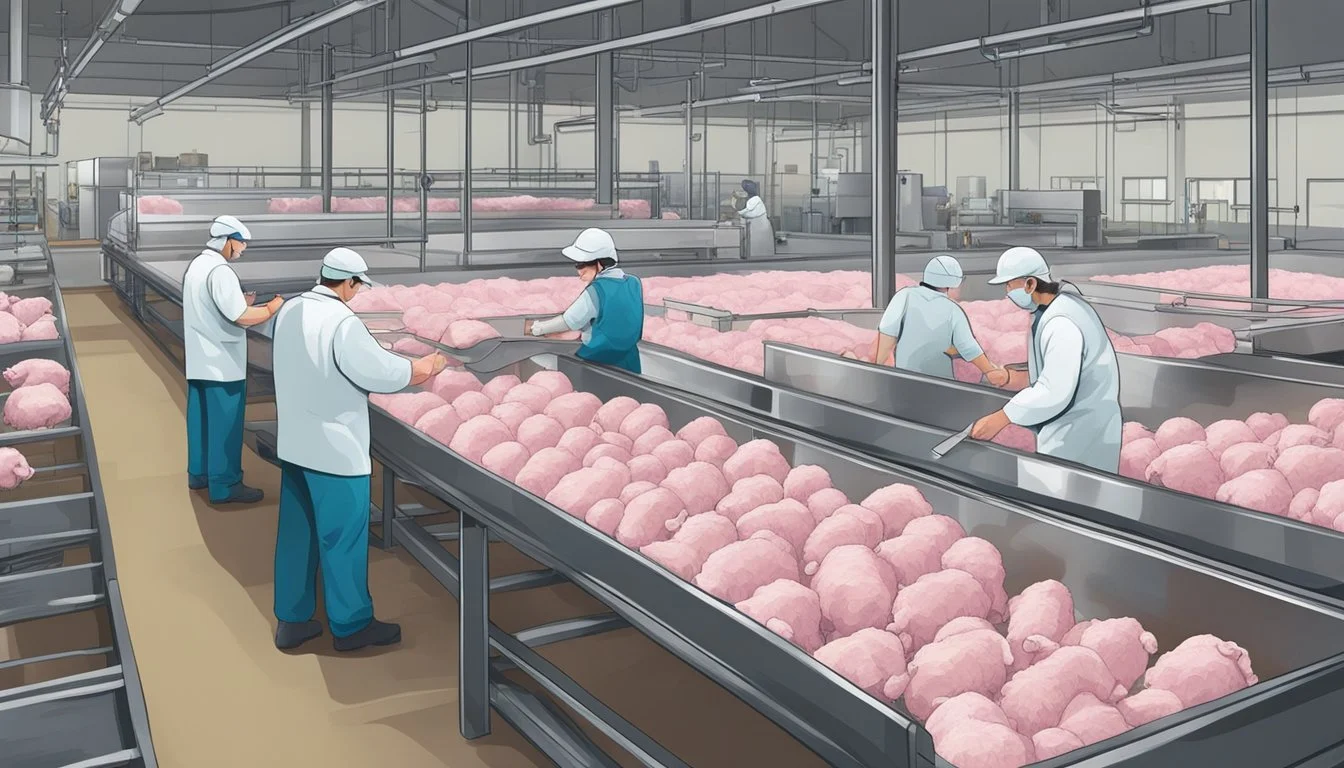Fresh vs Frozen Lamb: Comparing Quality, Flavor, and Cooking Performance
When it comes to choosing lamb for your next meal, you may wonder whether fresh or frozen is the better option. Both have their merits, and the choice often depends on factors like availability, convenience, and intended use.
Fresh lamb typically offers superior texture and flavor compared to its frozen counterpart. The meat retains its natural moisture and tenderness, making it ideal for dishes where the lamb is the star. Fresh cuts also allow for more precise cooking, as there's no need to account for thawing time or moisture loss during the freezing process.
Frozen lamb, however, provides convenience and extended shelf life. It allows consumers to purchase lamb when prices are favorable and store it for future use. While freezing can slightly alter the texture due to ice crystal formation, properly frozen and thawed lamb can still yield excellent results in many recipes. The key lies in proper handling and defrosting techniques to maintain quality.
Understanding Fresh and Frozen Lamb
Fresh and frozen lamb offer different qualities and characteristics that impact their taste, texture, and nutritional value. Both options have advantages for consumers depending on their preferences and needs.
Definition of Fresh Meat
Fresh lamb refers to meat that has not been frozen since slaughter. It is typically refrigerated and sold within days of processing. Fresh lamb maintains its original moisture content and cellular structure.
The meat appears bright red and feels firm to the touch. It often has a more intense flavor profile compared to frozen alternatives. Fresh lamb is highly perishable and should be consumed within a few days of purchase.
Butchers and specialty shops commonly offer fresh cuts, allowing customers to select specific portions. The limited shelf life of fresh lamb can lead to higher prices due to increased logistics and handling requirements.
Definition of Frozen Meat
Frozen lamb is meat that has been rapidly chilled to temperatures below -18°C (0°F). This process preserves the meat by halting bacterial growth and enzymatic activity. Freezing occurs shortly after slaughter and processing.
The meat can be stored for extended periods, typically up to 6-12 months, while maintaining quality. Frozen lamb is widely available in supermarkets and offers convenience for consumers.
During freezing, ice crystals form within the meat's cells. This can affect texture and moisture content upon thawing. Properly frozen and thawed lamb can retain much of its original flavor and nutritional value.
Comparison of Fresh and Frozen Meat
Fresh and frozen lamb differ in several aspects of meat quality and sensory attributes. Studies have shown that freezing can impact water retention, tenderness, and juiciness, particularly in certain cuts like the longissimus lumborum muscle.
Fresh lamb initially has higher nutrient content, but vitamin and mineral levels may decrease over time. Frozen lamb maintains nutrient levels well, though some loss can occur during thawing.
Texture variations exist between fresh and frozen options. Fresh lamb tends to have a firmer texture, while frozen lamb may be slightly softer due to ice crystal formation.
Cooking methods may need adjustment for frozen lamb to ensure even heating and optimal results. Both fresh and frozen lamb can produce high-quality meals when handled and prepared correctly.
Nutritional Value of Lamb
Lamb is a nutrient-dense meat that offers a variety of essential nutrients. Its nutritional profile can be affected by factors like the cut of meat and processing methods.
Nutritional Profile of Lamb Meat
Lamb is an excellent source of high-quality protein, containing all essential amino acids. A 100-gram serving of roasted lamb provides approximately 25-30 grams of protein.
Lamb also contains significant amounts of B vitamins, particularly B12, which is crucial for nerve function and red blood cell formation. It's rich in minerals like iron, zinc, and selenium.
The fat content in lamb varies depending on the cut. Leaner cuts like loin chops contain about 8-10% fat, while fattier cuts can have up to 20-25% fat. Lamb fat includes both saturated and unsaturated fats.
Lamb is a good source of omega-3 fatty acids, especially when grass-fed. These beneficial fats support heart and brain health.
Effects of Freezing on Nutritional Quality
Freezing lamb generally preserves its nutritional value well. The protein content remains stable during freezing and thawing processes.
Most vitamins and minerals in lamb are not significantly affected by freezing. However, some water-soluble vitamins like B vitamins may decrease slightly during the thawing process.
The fat composition of lamb remains largely unchanged when frozen. Proper freezing techniques can help maintain the quality of fats, including omega-3 fatty acids.
Freezing can cause minor changes in texture due to ice crystal formation, but these do not significantly impact the meat's nutritional value. Proper thawing methods can help minimize any nutrient loss.
Physical Characteristics of Lamb
Lamb meat exhibits distinct physical traits that can vary between fresh and frozen forms. These characteristics play a crucial role in consumer perception and culinary applications.
Texture Differences
Fresh lamb typically has a firmer texture compared to frozen lamb. The muscle fibers in fresh lamb remain intact, providing a more cohesive and tender bite. When frozen, ice crystals form within the meat, potentially disrupting the cellular structure.
This can lead to a slightly softer texture upon thawing. However, proper freezing and thawing techniques can minimize these differences. High-quality frozen lamb, when handled correctly, can still maintain much of its original texture.
Colour and Appearance
Fresh lamb displays a bright red to pinkish-red hue, indicative of its myoglobin content. The meat surface appears moist and glossy. Marbling, the intramuscular fat, is visible as thin white lines throughout the cut.
Frozen lamb may appear slightly darker or duller in color upon thawing. This is due to oxidation processes that occur during freezing and storage. The meat's surface might also seem less moist compared to fresh lamb.
Properly frozen lamb should not show signs of freezer burn, which manifests as grayish-brown patches on the meat's surface.
Effects of Freezing on Lamb Meat
Freezing lamb meat impacts its quality, texture, and flavor through various processes. These effects are influenced by freezing methods, storage conditions, and duration.
Freezer Storage Conditions
Proper freezer storage is crucial for maintaining lamb quality. The ideal freezer temperature for lamb is 0°F (-18°C) or below. At this temperature, lamb can be safely stored for 6 to 9 months while retaining acceptable quality.
Higher temperatures or temperature fluctuations can negatively impact meat quality. Vacuum-sealed packaging helps prevent freezer burn and moisture loss during storage.
Lamb cuts like chops, roasts, and steaks have different optimal storage times. Ground lamb typically has a shorter freezer life compared to whole cuts.
Formation of Intracellular Ice Crystals
When lamb meat freezes, water within muscle cells forms ice crystals. The size and distribution of these crystals affect meat quality after thawing.
Rapid freezing produces smaller, more evenly distributed ice crystals. This results in less cellular damage and better texture retention.
Slow freezing leads to larger ice crystals that can rupture cell membranes. This causes increased moisture loss (drip loss) upon thawing.
Advanced freezing methods like blast freezing or nitrogen freezing can minimize ice crystal damage.
Meat Quality Changes During Freezing
Freezing affects various aspects of lamb meat quality. Color changes may occur, with frozen lamb often appearing slightly darker than fresh meat upon thawing.
Moisture loss during freezing and thawing can impact juiciness and tenderness. Studies show increased drip loss in frozen lamb compared to fresh.
Cooking losses may be higher in previously frozen lamb. This can affect the final cooked weight and potentially impact texture.
Freezing can alter fat composition and oxidation rates, potentially affecting flavor over long storage periods.
Processing and Preservation Techniques
Processing and preservation techniques significantly impact lamb meat quality. Proper methods ensure food safety, extend shelf life, and maintain desirable sensory attributes.
Slaughter Methods for Lamb
Humane slaughter practices are crucial in lamb meat production. Stunning methods include electrical and mechanical techniques. Electrical stunning involves applying an electric current to the lamb's head, inducing immediate unconsciousness. Mechanical stunning uses a captive bolt pistol to render the animal insensible.
After stunning, exsanguination occurs within 15 seconds. This rapid blood loss ensures quick death and optimal meat quality. The carcass is then skinned and eviscerated in specialized abattoirs.
Proper hygiene during slaughter prevents microbial contamination. Workers wear protective clothing and follow strict sanitation protocols. Equipment is regularly cleaned and sanitized to maintain food safety standards.
Chilling and Freezing Protocols
Rapid chilling is essential for preserving lamb meat quality. Carcasses are typically chilled to 4-7°C within 24 hours of slaughter. Ultra-rapid chilling can reduce this time to 7 hours, allowing same-day dispatch.
Chilling methods include:
Spray chilling: Fine water mist cools carcasses quickly
Air chilling: Cold air circulates around hanging carcasses
Immersion chilling: Carcasses are submerged in cold water
Freezing further extends shelf life. Lamb is frozen at -18°C or lower, halting bacterial growth. Quick freezing methods, such as blast freezing, minimize ice crystal formation and preserve meat texture.
Lamb Meat Packaging and Storage
Proper packaging protects lamb meat from contamination and extends shelf life. Common packaging methods include:
Vacuum packaging: Removes air, inhibiting bacterial growth
Modified atmosphere packaging: Replaces air with specific gas mixtures
Overwrap packaging: Plastic film covers meat on foam trays
Storage temperature is critical. Fresh lamb should be stored at 1-4°C. Frozen lamb maintains quality at -18°C or lower for up to 12 months.
Packaging materials must be food-grade and provide adequate moisture and oxygen barriers. Labels should include storage instructions and use-by dates to ensure food safety and quality.
Cooking and Preparation
Proper cooking techniques are crucial for maximizing the flavor and texture of lamb, whether fresh or frozen. The preparation method can significantly impact the final result.
Impact of Thawing on Meat Quality
Thawing frozen lamb correctly is essential to maintain its quality. Slow thawing in the refrigerator is ideal, as it minimizes moisture loss and preserves texture. This method typically takes 24 hours for every 4-5 pounds of meat.
Rapid thawing methods, such as using cold water or a microwave, can be used in a pinch but may affect meat quality. These methods can lead to uneven thawing and partial cooking of outer layers.
Thawing loss, the moisture released during defrosting, is generally minimal when done properly. However, improper thawing can result in a drier end product.
Cooking Fresh Versus Frozen Lamb
Fresh lamb cooks more evenly and often requires less time than frozen. It allows for easier seasoning and marinating, as flavors penetrate the meat more readily.
Frozen lamb can be cooked without thawing, but it requires longer cooking times. For oven roasting, add about 50% more time to the usual cooking duration. For example, a leg of lamb that normally takes 3 hours might need 4.5 hours from frozen.
Slow cooking methods, like braising or using a slow cooker, work well for frozen lamb. These techniques help maintain moisture and tenderness.
Cooking Loss and Sensory Attributes
Cooking loss refers to the reduction in weight during cooking due to moisture evaporation and fat melting. Fresh lamb typically experiences less cooking loss than frozen, resulting in a juicier texture.
Flavor differences between fresh and frozen lamb are often minimal when cooked properly. However, fresh lamb may have a slightly more pronounced flavor due to less moisture loss during preparation.
Texture can vary, with fresh lamb often yielding a more tender result. Frozen lamb, if not thawed and cooked carefully, may have a slightly tougher texture.
To minimize cooking loss and enhance sensory attributes:
Use a meat thermometer to avoid overcooking
Let the meat rest after cooking to redistribute juices
Consider using marinades or brines to enhance moisture retention
Sensory and Consumptive Experience
The sensory attributes of lamb meat play a crucial role in consumer satisfaction. Taste, tenderness, and juiciness are key factors that influence the overall eating experience.
Taste and Flavour Profiles
Fresh and frozen lamb exhibit distinct flavor characteristics. Fresh lamb typically offers a more pronounced, robust taste with subtle grassy notes. Frozen lamb may have a slightly milder flavor profile due to the freezing process.
Enzymes in the meat continue to break down proteins during frozen storage, potentially enhancing flavor development. This process can lead to a more complex taste in frozen lamb when properly thawed and prepared.
Odor also contributes to the overall sensory experience. Fresh lamb often has a stronger aroma compared to its frozen counterpart. Proper freezing techniques help preserve the natural scent of the meat.
Tenderness and Juiciness
Tenderness is a critical factor in lamb meat quality. Fresh lamb is generally perceived as more tender due to its natural moisture content and protein structure. Freezing can affect the texture of meat fibers.
Proper thawing techniques are essential for maintaining the tenderness of frozen lamb. Slow, controlled thawing in the refrigerator helps minimize moisture loss and preserve texture.
Juiciness is closely linked to tenderness and affects overall palatability. Fresh lamb often retains more natural juices, contributing to a succulent eating experience. Frozen lamb may experience some moisture loss during the freezing and thawing process.
Aging plays a role in both fresh and frozen lamb tenderness. Extended freezing periods can act as a form of aging, potentially improving tenderness in some cases.
Scientific Analysis and Studies
Scientific studies have employed advanced techniques to analyze differences between fresh and frozen lamb meat. These methods provide objective data on meat quality and composition.
LF-NMR Analysis
Low-field nuclear magnetic resonance (LF-NMR) offers insights into water and lipid distribution in lamb meat. This technique measures proton relaxation times, correlating to moisture content and fat distribution.
Studies show frozen lamb typically has longer T2 relaxation times compared to fresh samples. This indicates increased water mobility and potential moisture loss during thawing.
LF-NMR analysis also reveals changes in lipid structure after freezing. The formation of ice crystals can disrupt fat globules, leading to altered texture and mouthfeel.
Assessment of Meat Quality via WB Shear Force
Warner-Bratzler (WB) shear force testing quantifies meat tenderness by measuring the force required to cut through a standardized meat sample.
Research demonstrates frozen lamb often exhibits higher shear force values than fresh lamb. This suggests a decrease in tenderness after freezing and thawing.
Factors influencing WB shear force in frozen lamb include:
Freezing rate
Storage temperature
Thawing method
Duration of frozen storage
Proper handling and processing can minimize tenderness losses in frozen lamb. Rapid freezing and controlled thawing help preserve meat structure and quality.
Industry and Regulatory Perspectives
The lamb industry operates under strict regulations and standards to ensure meat quality and safety. Government agencies and international bodies play key roles in overseeing production, processing, and trade practices for both fresh and frozen lamb products.
USDA Regulations for Lamb Meat
The United States Department of Agriculture (USDA) sets comprehensive guidelines for lamb meat production and sales. Fresh lamb must be stored at 40°F or below, while frozen lamb should be kept at 0°F or lower. The USDA grades lamb based on quality factors like marbling and maturity.
Grades include Prime, Choice, and Good for younger lambs, with lower grades for older sheep. These standards help consumers make informed decisions about meat quality. Retailers must follow specific labeling requirements, including country of origin and nutritional information.
USDA inspectors regularly check processing facilities to ensure compliance with food safety regulations. This includes monitoring for proper handling, sanitation, and temperature control throughout the supply chain.
International Standards for Meat Quality
Global organizations work to harmonize meat quality standards across borders. The Codex Alimentarius Commission, established by the FAO and WHO, develops international food standards including those for lamb meat.
These guidelines cover aspects such as:
Microbiological criteria
Contaminant limits
Hygiene practices
Labeling requirements
Many countries have adopted these standards or use them as a basis for national regulations. The World Organisation for Animal Health (OIE) sets animal welfare standards that impact lamb production practices worldwide.
For international trade, countries often require health certificates and may impose additional quality control measures. This ensures that imported lamb meets local safety and quality expectations, whether fresh or frozen.







